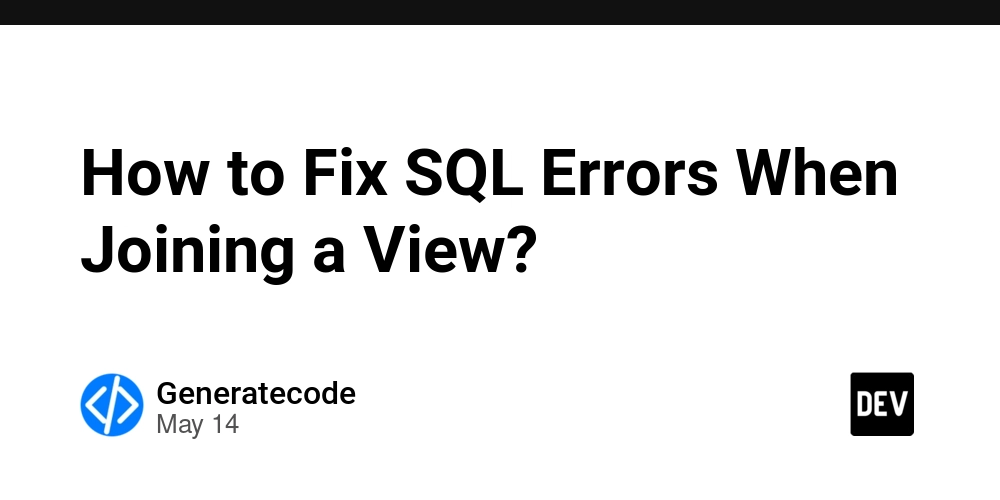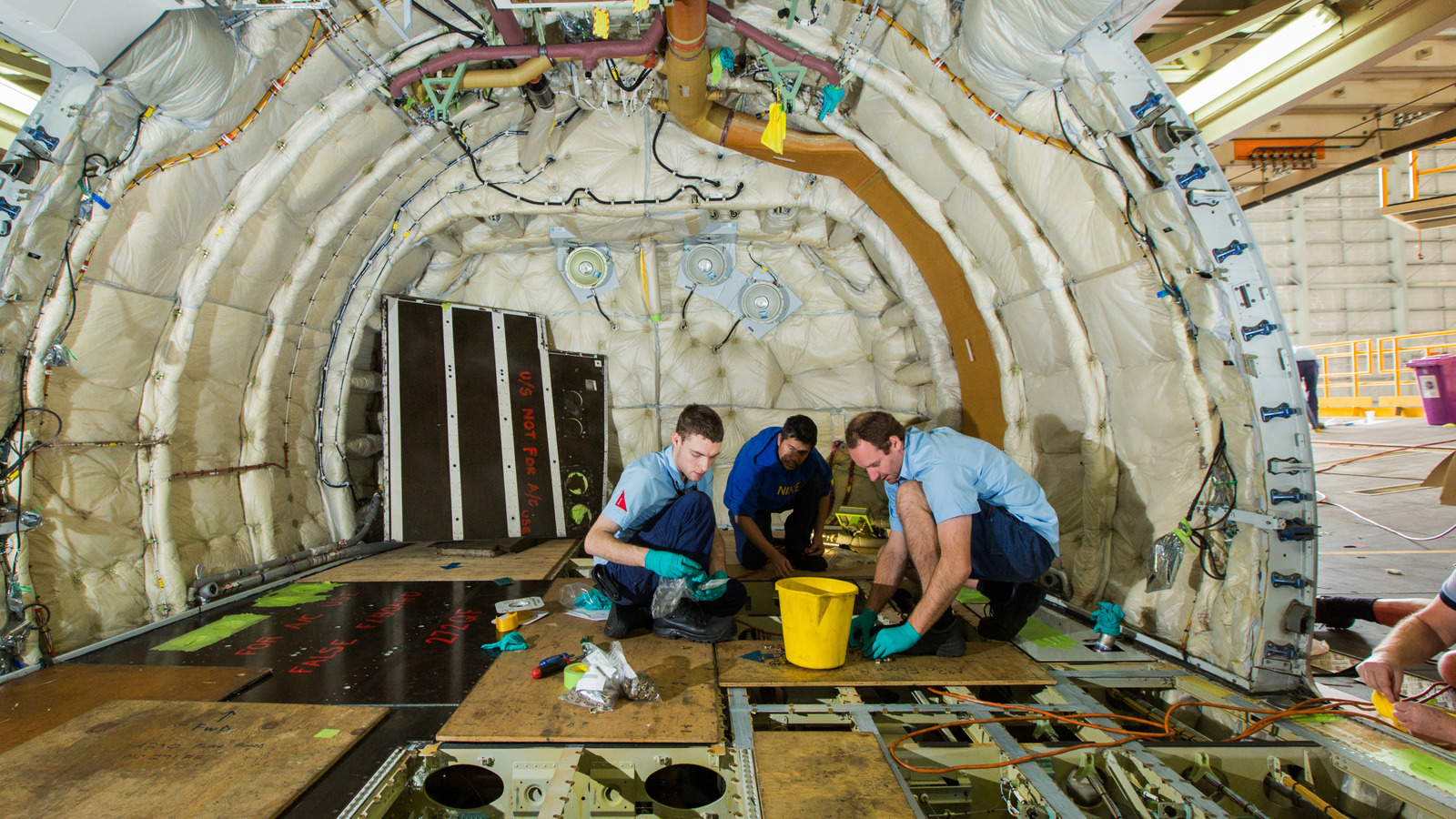How to Fix SQL Errors When Joining a View?
Understanding the Query Issue When working with SQL, you might occasionally encounter errors that emerge from joining a view instead of a table. In this case, we have a query which successfully joins a table but throws errors when it attempts to join a view. Let's unpack the problem and find a solution together. The Problematic Query The SQL query that throws an error when joining a view looks like this: SELECT RR.REQUEST_ID FROM CCS_REQUEST_RESPONSE RR INNER JOIN VW_STUDENT_CURRENT_AND_HIST VW ON RR.STUDENTID = VW.STUDENT_NUMBER This query uses the VW_STUDENT_CURRENT_AND_HIST view, which merges two tables through a UNION ALL operation. Initially, you might have expected it to work just like joining to a single table: SELECT RR.REQUEST_ID FROM CCS_REQUEST_RESPONSE RR INNER JOIN HISTORICAL_STUDENTS VW ON RR.STUDENTID = VW.STUDENT_NUMBER Why the Issue Happens If your query used to work fine and suddenly stopped, it could indicate a few potential issues. Here are some key areas to investigate: View Definition Changes: The underlying tables in the view definition may have changed. Check if there are new constraints or data type changes affecting the STUDENT_NUMBER columns. Data Issues: It’s possible that the view is now returning unexpected results, such as NULL values or duplicate entries that could be leading to join issues. Run a diagnostic query like: SELECT * FROM VW_STUDENT_CURRENT_AND_HIST; Check for any anomalies that could influence the join. Permissions: Sometimes, permission changes can cause queries to fail unexpectedly. Ensure that your user has read access to the view and both underlying tables. Steps to Resolve the Error To get to the bottom of the problem, you can follow these steps: Step 1: Verify the View Run this query to ensure the view is functioning correctly: SELECT * FROM VW_STUDENT_CURRENT_AND_HIST; Check to see if it retrieves the expected data. Step 2: Confirm Column Types Ensure that the columns used in your join condition, STUDENTID and STUDENT_NUMBER, are of the same data type. You can check the data types with: SELECT DATA_TYPE FROM USER_TAB_COLS WHERE TABLE_NAME = 'CCS_REQUEST_RESPONSE' AND COLUMN_NAME = 'STUDENTID'; SELECT DATA_TYPE FROM USER_TAB_COLS WHERE VIEW_NAME = 'VW_STUDENT_CURRENT_AND_HIST' AND COLUMN_NAME = 'STUDENT_NUMBER'; If they differ, you may need to cast one of the values to align the types: SELECT RR.REQUEST_ID FROM CCS_REQUEST_RESPONSE RR INNER JOIN VW_STUDENT_CURRENT_AND_HIST VW ON CAST(RR.STUDENTID AS VARCHAR) = VW.STUDENT_NUMBER; Step 3: Check for NULL Values Inspect the underlying tables for any NULL values that could impact the join condition: SELECT COUNT(*) AS NULL_COUNT FROM VW_STUDENT_CURRENT_AND_HIST WHERE STUDENT_NUMBER IS NULL; If there are NULL values, you may want to modify the join with an additional condition to handle these appropriately: SELECT RR.REQUEST_ID FROM CCS_REQUEST_RESPONSE RR INNER JOIN VW_STUDENT_CURRENT_AND_HIST VW ON RR.STUDENTID = VW.STUDENT_NUMBER WHERE VW.STUDENT_NUMBER IS NOT NULL; Step 4: Substitute for Debugging As a temporary workaround, you might continue using the individual tables directly (as you noted they work) until you've identified why the view is causing issues. For example: SELECT RR.REQUEST_ID FROM CCS_REQUEST_RESPONSE RR INNER JOIN HISTORICAL_STUDENTS VW ON RR.STUDENTID = VW.STUDENT_NUMBER; Frequently Asked Questions Q1: What is a view in SQL? A view is a virtual table that is based on the result of a SELECT query. It allows you to store complex queries for easier reuse. Q2: How do I troubleshoot view-related join errors? Check the view's definition, verify the data types of joining columns, examine for NULL values, and ensure proper permissions are in place. Q3: Can a view return duplicates? Yes, if the underlying tables have duplicate data, a view defined with UNION ALL will also include duplicates in its results. Conclusion In summary, joining a view versus a table can lead to errors primarily due to data type mismatches, NULL values, or issues arising from view definition changes. By following the troubleshooting steps outlined, you can systematically identify and resolve the issue. Always ensure your join constraints are clear and the data is as expected to maintain smooth operation within your SQL queries.

Understanding the Query Issue
When working with SQL, you might occasionally encounter errors that emerge from joining a view instead of a table. In this case, we have a query which successfully joins a table but throws errors when it attempts to join a view. Let's unpack the problem and find a solution together.
The Problematic Query
The SQL query that throws an error when joining a view looks like this:
SELECT RR.REQUEST_ID
FROM CCS_REQUEST_RESPONSE RR
INNER JOIN VW_STUDENT_CURRENT_AND_HIST VW
ON RR.STUDENTID = VW.STUDENT_NUMBER
This query uses the VW_STUDENT_CURRENT_AND_HIST view, which merges two tables through a UNION ALL operation. Initially, you might have expected it to work just like joining to a single table:
SELECT RR.REQUEST_ID
FROM CCS_REQUEST_RESPONSE RR
INNER JOIN HISTORICAL_STUDENTS VW
ON RR.STUDENTID = VW.STUDENT_NUMBER
Why the Issue Happens
If your query used to work fine and suddenly stopped, it could indicate a few potential issues. Here are some key areas to investigate:
-
View Definition Changes: The underlying tables in the view definition may have changed. Check if there are new constraints or data type changes affecting the
STUDENT_NUMBERcolumns. -
Data Issues: It’s possible that the view is now returning unexpected results, such as
NULLvalues or duplicate entries that could be leading to join issues. Run a diagnostic query like:SELECT * FROM VW_STUDENT_CURRENT_AND_HIST;Check for any anomalies that could influence the join.
-
Permissions: Sometimes, permission changes can cause queries to fail unexpectedly. Ensure that your user has read access to the view and both underlying tables.
Steps to Resolve the Error
To get to the bottom of the problem, you can follow these steps:
Step 1: Verify the View
Run this query to ensure the view is functioning correctly:
SELECT * FROM VW_STUDENT_CURRENT_AND_HIST;
Check to see if it retrieves the expected data.
Step 2: Confirm Column Types
Ensure that the columns used in your join condition, STUDENTID and STUDENT_NUMBER, are of the same data type. You can check the data types with:
SELECT DATA_TYPE
FROM USER_TAB_COLS
WHERE TABLE_NAME = 'CCS_REQUEST_RESPONSE' AND COLUMN_NAME = 'STUDENTID';
SELECT DATA_TYPE
FROM USER_TAB_COLS
WHERE VIEW_NAME = 'VW_STUDENT_CURRENT_AND_HIST' AND COLUMN_NAME = 'STUDENT_NUMBER';
If they differ, you may need to cast one of the values to align the types:
SELECT RR.REQUEST_ID
FROM CCS_REQUEST_RESPONSE RR
INNER JOIN VW_STUDENT_CURRENT_AND_HIST VW
ON CAST(RR.STUDENTID AS VARCHAR) = VW.STUDENT_NUMBER;
Step 3: Check for NULL Values
Inspect the underlying tables for any NULL values that could impact the join condition:
SELECT COUNT(*) AS NULL_COUNT
FROM VW_STUDENT_CURRENT_AND_HIST
WHERE STUDENT_NUMBER IS NULL;
If there are NULL values, you may want to modify the join with an additional condition to handle these appropriately:
SELECT RR.REQUEST_ID
FROM CCS_REQUEST_RESPONSE RR
INNER JOIN VW_STUDENT_CURRENT_AND_HIST VW
ON RR.STUDENTID = VW.STUDENT_NUMBER
WHERE VW.STUDENT_NUMBER IS NOT NULL;
Step 4: Substitute for Debugging
As a temporary workaround, you might continue using the individual tables directly (as you noted they work) until you've identified why the view is causing issues. For example:
SELECT RR.REQUEST_ID
FROM CCS_REQUEST_RESPONSE RR
INNER JOIN HISTORICAL_STUDENTS VW
ON RR.STUDENTID = VW.STUDENT_NUMBER;
Frequently Asked Questions
Q1: What is a view in SQL?
A view is a virtual table that is based on the result of a SELECT query. It allows you to store complex queries for easier reuse.
Q2: How do I troubleshoot view-related join errors?
Check the view's definition, verify the data types of joining columns, examine for NULL values, and ensure proper permissions are in place.
Q3: Can a view return duplicates?
Yes, if the underlying tables have duplicate data, a view defined with UNION ALL will also include duplicates in its results.
Conclusion
In summary, joining a view versus a table can lead to errors primarily due to data type mismatches, NULL values, or issues arising from view definition changes. By following the troubleshooting steps outlined, you can systematically identify and resolve the issue. Always ensure your join constraints are clear and the data is as expected to maintain smooth operation within your SQL queries.



































































































































































![[The AI Show Episode 147]: OpenAI Abandons For-Profit Plan, AI College Cheating Epidemic, Apple Says AI Will Replace Search Engines & HubSpot’s AI-First Scorecard](https://www.marketingaiinstitute.com/hubfs/ep%20147%20cover.png)

































































































































































































![Legends Reborn tier list of best heroes for each class [May 2025]](https://media.pocketgamer.com/artwork/na-33360-1656320479/pg-magnum-quest-fi-1.jpeg?#)


































































_KristofferTripplaar_Alamy_.jpg?width=1280&auto=webp&quality=80&disable=upscale#)


.webp?#)
















































































-xl.jpg)






























![Vision Pro May Soon Let You Scroll With Your Eyes [Report]](https://www.iclarified.com/images/news/97324/97324/97324-640.jpg)
![Apple's 20th Anniversary iPhone May Feature Bezel-Free Display, AI Memory, Silicon Anode Battery [Report]](https://www.iclarified.com/images/news/97323/97323/97323-640.jpg)





































































































